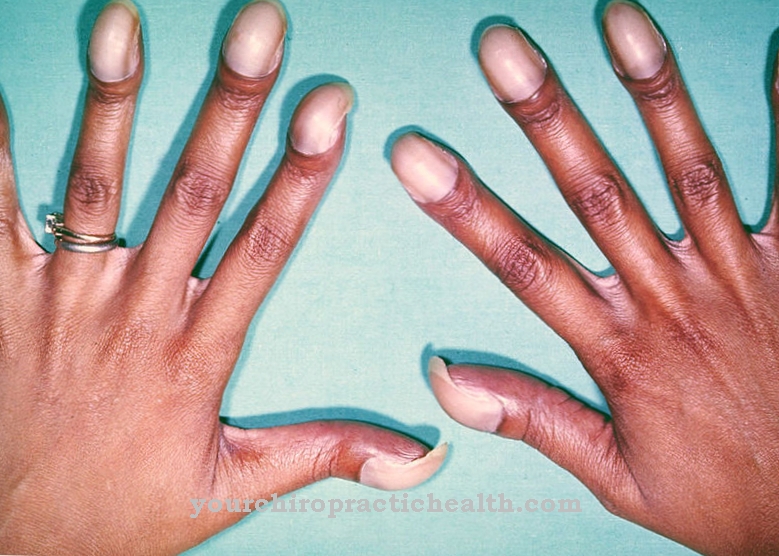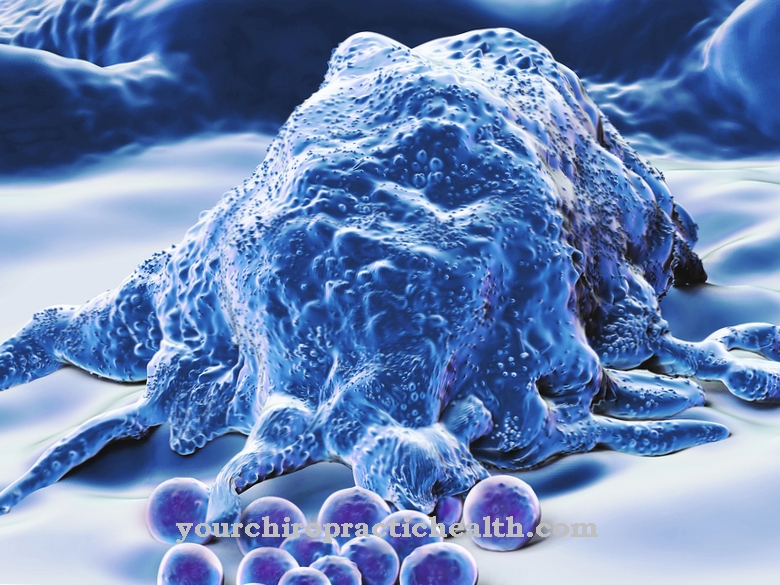The smallpox or. Scroll are an extreme and highly contagious infectious disease. It is caused by viruses and transmitted through droplet infection, dust or direct contact. Typical signs are the infectious and contagious pus blisters or pustules. Smallpox, which is often fatal, should not be confused with the more harmless chickenpox in children.
What is smallpox?

© Kateryna_Kon - stock.adobe.com
Smallpox (pox, variola) are a highly contagious, acute, reportable infectious disease and should not be confused with the childhood disease of chickenpox. The pathogen is the Variolavirus belonging to the Poxviridae family. The transmission takes place through droplet, smear and dust infection. The incubation period is 7-11 days. In 1980 the World Health Organization declared this disease to be eradicated after a global vaccination program. The general compulsory vaccination was lifted; however, international vaccination and quarantine regulations remain in effect.
The real smallpox (Variola major, Variola vera) is caused by Orthopoxvirus variola. Smallpox has been an endemic disease since around 1000 BC. Known in China, India and Arabia. In Europe, the first known epidemic occurred in the 6th century, followed by others in the 13th century in England and at the end of the 15th century in Germany. Smallpox was still endemic in Europe in the 19th century; In 1871-73 175,000 cases with more than 100,000 fatalities were registered in Germany. Although smallpox is now assumed to be successful in eradicating smallpox, medicine can never be 100% sure whether the disease will break out again at some point or another.
causes
The Smallpox Virus (Poxviridae) are a family of very large, complex viruses with oval or cuboid shape, which are widespread pathogens in vertebrates and insects. With dimensions of 300 × 200 × 150 nm, smallpox viruses can be detected with a light microscope. The infection manifests itself on the skin and mucous membrane. The genus of orthopox viruses includes eight related virus strains that lead to infections with skin symptoms and can usually only infect the respective host and closely related host species.
In addition to camel, cow, mouse and monkey pox viruses, the variola and vaccinia viruses are found here. The variola virus is the causative agent of smallpox in humans, which has been feared for centuries. In addition to the viruses that cause hemorrhagic fever (Ebola and Lassa virus), anthrax, plague, tularemia (rabbit plague) and botulinum toxin, it is classified in category A, the highest risk class of the bioterror pathogens.
Symptoms, ailments & signs
Probably the most typical and noticeable symptoms of smallpox are the papules, which to unsuspecting laypeople perceive as blisters or a rash. These papules come in a wide variety of shapes and sizes. But before such a smallpox rash becomes visible, other symptoms and signs appear.
These include, for example, severe back pain, fever, inflammation of the respiratory tract, body aches or long-lasting headaches. In addition, there are small red blisters on the tongue and in the throat, which are regarded as harbingers of said smallpox. In most cases, smallpox occurs directly on the face and is associated with severe itching.
The constant scratching of the face can even cause open wounds, so that inflammation and the formation of pus are possible. After a while, the papules turn into hard crusts that will then fall off by themselves. Unsightly scars remain and remain for some time. Smallpox is accompanied by very clear symptoms, which are usually associated with severe itching. Symptoms can only be relieved with the right medication. Otherwise, a significant deterioration can be expected.
Course of disease
After an initial stage of 2-4 days with a high fever, headache, lower back and limb pain, inflammation of the upper respiratory tract and a temporary rash, with a brief drop in fever in the subsequent eruption stage, the characteristic formation of pale red, itchy spots that turn into nodules, Vesicles, papules, and pustules develop. They usually spread from the head over the whole body and dry up after a few weeks with bark and scab formation. After the (infectious) crusts are shed, the typical pockmarks remain.
Complications
Smallpox has several complications that depend on the severity of the disease and how the symptoms are treated. The disease from real smallpox leads to death in about 30 percent of cases. In addition, the disease leaves scars on survivors. If the eyes, inner ear, nervous system or other important sensory organs have been severely affected, this often results in blindness, deafness, paralysis or general nerve and brain damage. Smallpox leaves long-term effects on all those affected.
The occurrence of hemorrhagic smallpox (black pox) is a particular complication. Its symptoms are more serious than those of other smallpox diseases. They mean the occurrence of internal bleeding, massive bruises and thus damage to the vital organs. Those affected usually die within 48 hours, but at the latest after a few days.
Monkey pox and cowpox are special cases, of which there have been a few cases in recent years. This mild form usually heals on its own within a few weeks. However, because it attacks the nervous system, it can also lead to the complications of real smallpox. This is especially true for people with a weakened immune system.
When should you go to the doctor?
Smallpox must always be examined and treated by a doctor. If there is no treatment for this disease, in the worst case scenario, the affected person can die from smallpox. In most cases, the symptoms worsen over time and there is no self-healing. A doctor should be consulted in the case of smallpox if a severe rash and papules develop on the skin of the person concerned. This often results in severe back pain, fever or even body aches and headaches.
If these symptoms occur together with the papules, a doctor should be consulted immediately. In some cases, smallpox also manifests itself through diseases of the respiratory tract. The disease can be diagnosed and treated by a general practitioner or in a hospital. With the help of vaccinations, a fatal course of smallpox can be avoided. Early treatment by a doctor can also prevent a fatal outcome.
Treatment & Therapy
The actual vaccination protection against smallpox was made possible by E. Jenner in 1796 by vaccination with bovine pox lymph. He created the basis for the successful control in connection with the later vaccination laws. If smallpox is used as a biological weapon, it poses a serious threat to the civilian population. The mortality rate in the unvaccinated is 30% (or more) and there is no specific treatment option.
Although smallpox was the most feared infectious disease for a long time, its potential hazard is greater today than in previous centuries. The mandatory vaccinations were discontinued in many countries around 25 years ago. Vaccination carried out within four days of exposure appears to provide some protection against smallpox infection and significant protection against fatal outcome.
As a countermeasure for the eventuality, smallpox vaccine is available worldwide today. Vaccinia u. a. Smallpox viruses are used in the biosciences as vectors for expressing foreign proteins, as well as for the development of novel vaccines. Surviving the disease confers lifelong immunity. In the case of incomplete immunity, the course is severely moderated in the 2nd phase (variolois). White smallpox or milkpox (Variola minor or Alastrim), which are caused by Orthopoxvirus alastrim, represent a milder form of the disease; they leave no immunity to real smallpox.
Aftercare
Smallpox is largely considered to be eradicated. Patients who have suffered from the leaflets and have overcome the condition must continue to seek medical care. After the end of the therapy, the doctors check the patient's state of health at regular intervals. In this way, accompanying symptoms can be identified at an early stage.
Despite extensive treatment, the viruses may have survived in the body and lead to smallpox again. Since the symptoms usually return in the first few weeks or months, follow-up care takes place significantly more often at the beginning. The dates can be gradually reduced. This is accompanied by rest and bed rest, because the disease has a strong effect on the immune system.
As a precautionary measure, the skin should continue to be protected and any injuries or scarring should be treated according to the doctor's instructions. Follow-up care is carried out by a resident dermatologist who contacts the responsible family doctor and the internists involved.
For this, the doctor needs all important documents and medical records. As part of the follow-up care, further screenings may be carried out in order to rule out permanent damage to the skin and secondary diseases or to detect abnormalities in good time. The further aftercare measures always depend on the course of the disease.
You can do that yourself
Since smallpox is one of the diseases that are highly contagious and, if unfavorable, can also be fatal, those affected should consult a doctor at the first sign and follow the doctor's instructions. The disease is considered to be eradicated in our region. Therefore, there is hardly any evidence for self-help.
If irregularities nevertheless occur, there is a special obligation to act. Smallpox has to be reported due to its explosive nature and is subject to international quarantine regulations. Independent health care is neither advisable nor permitted. Timely vaccination protection is recommended as protection against the disease. This should be done independently so that immunity against the pathogens occurs. If a case of illness becomes known in the immediate vicinity, you should also consult a doctor as soon as possible.
The illness is associated with symptoms such as a high fever. Although there is a loss of appetite and strength, it must be ensured that the organism has sufficient nutrients available. The amount of fluid should be adjusted to the needs of the body and must be increased compared to normal circumstances. The changes in the complexion of the skin trigger intense itching. Despite the inconvenience, care must be taken not to give in to the itchy feeling if possible. This increases the risk of sepsis and this should be prevented.

.jpg)
.jpg)


.jpg)









.jpg)







.jpg)




